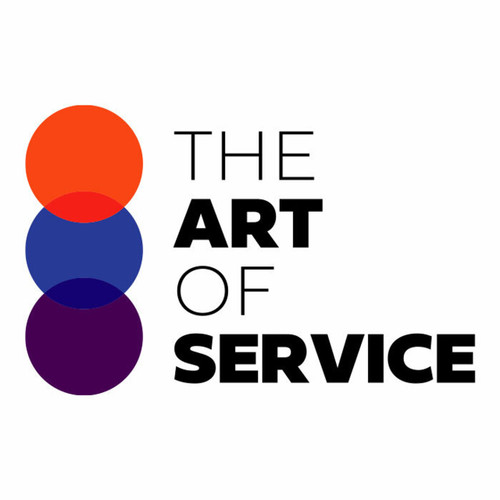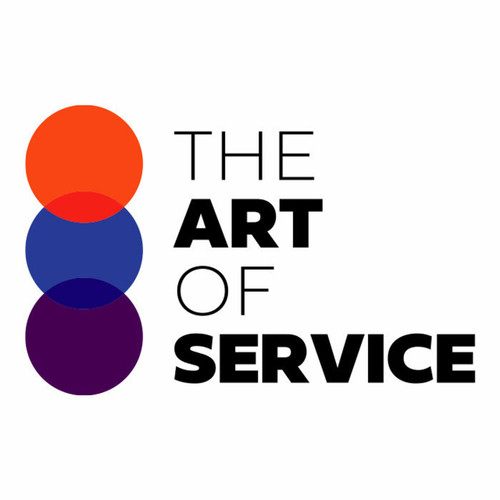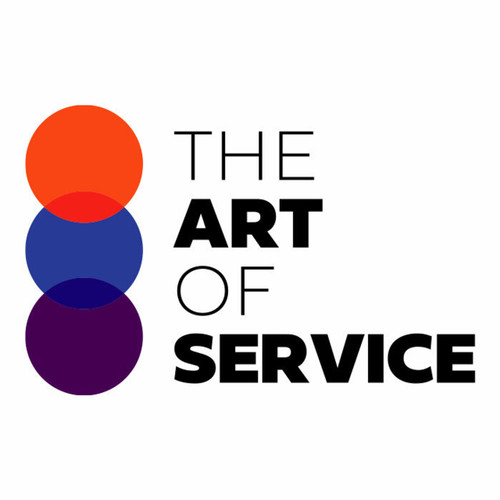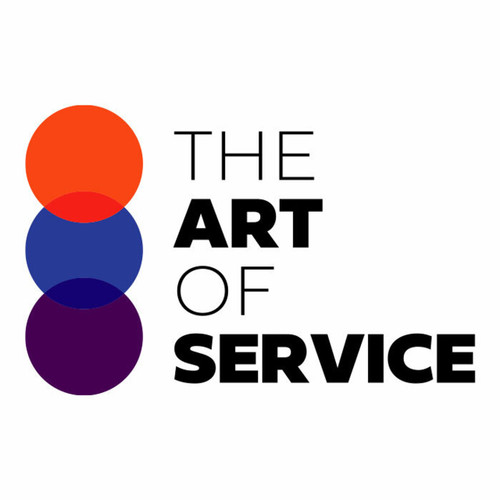Is your team struggling to keep up with the constantly evolving world of work? Are you looking for innovative solutions to help your organization thrive in the age of automation, robotics, and virtual reality?Introducing the Hybrid Workforce and Future of Work, How to Thrive in the Age of Automation, Robotics, and Virtual Reality Knowledge Base.
This comprehensive dataset contains 1518 prioritized requirements, solutions, benefits, and results to help you navigate the challenges and opportunities of the modern workplace.
Our expertly curated database covers urgent and wide-ranging topics, allowing you to gather critical information quickly and make informed decisions.
Unlike other datasets on the market, ours goes beyond generic information and provides practical, actionable insights that can be implemented immediately.
We know that every business is unique, which is why our dataset includes a variety of use cases and real-life examples to demonstrate how our solutions have helped organizations just like yours succeed.
But why choose our Hybrid Workforce and Future of Work dataset over competitors or other alternatives? The answer is simple: it is designed specifically for professionals like you, making it the most reliable and effective tool to meet your needs.
Easy to use and affordable, this product is a must-have for any organization looking to stay ahead of the curve in the ever-changing world of work.
With detailed specifications and comprehensive research, our dataset helps you save time and resources by providing all the information you need in one place.
It covers a wide range of topics such as the benefits of a hybrid workforce, the role of automation and robotics in the future workplace, and the impact of virtual reality on employee productivity.
Not only is this dataset valuable for individual professionals, but it also offers tremendous benefits for businesses.
By utilizing the insights and solutions provided, companies can streamline processes, improve efficiency, and boost overall performance.
Plus, with our dataset, you can stay ahead of your competitors by embracing the latest technologies and strategies for success.
So why wait? Invest in our Hybrid Workforce and Future of Work, How to Thrive in the Age of Automation, Robotics, and Virtual Reality Knowledge Base today and take your organization to new heights.
With its cost-effective and user-friendly design, this versatile product is a no-brainer for any business looking to thrive in the changing landscape of work.
Don′t miss out on this opportunity to stay ahead of the curve and drive success for your team and organization.
Order now and see the results for yourself!
Discover Insights, Make Informed Decisions, and Stay Ahead of the Curve:
Key Features:
Comprehensive set of 1518 prioritized Hybrid Workforce requirements. - Extensive coverage of 151 Hybrid Workforce topic scopes.
- In-depth analysis of 151 Hybrid Workforce step-by-step solutions, benefits, BHAGs.
- Detailed examination of 151 Hybrid Workforce case studies and use cases.
- Digital download upon purchase.
- Enjoy lifetime document updates included with your purchase.
- Benefit from a fully editable and customizable Excel format.
- Trusted and utilized by over 10,000 organizations.
- Covering: Video Conferencing, Remote Team Building, Co Working Spaces, Workforce Diversity, Remote Working, Work From Anywhere, Flexibility In The Workforce, Cognitive Computing, Online Collaboration Tools, Digital Transformation, Virtual Meetings, Work Life Harmony, Cloud Computing, Robotic Process Automation, Wearable Technology, Artificial Intelligence In HR, Remote Workforce Management, Digital Meetings, Robotic Workforce, Work Life Balance, Digital Onboarding, Workforce Planning In The Digital Age, Remote Access, Technological Advancements, Blockchain In Human Resources, Remote Job Opportunities, Flexible Work Environment, Human Machine Interaction, Adaptive Leadership, Employee Well Being, Digital Skills Gap, Future Workforce, Automation In Healthcare, Intelligent Automation, Future Of Work, Artificial Intelligence Ethics, Productivity Apps, Virtual Assistants, Artificial Intelligence In Education, Digital Nomads, Digital Marketing Strategies, Smart Offices, Augmented Learning, Internet Of Things, Augmented Reality Implementation, Future Of Education, Collaborative Innovation, Remote Management, Virtual Team Building, Cybersecurity Training, Remote Work Productivity, AI Powered Personalization, Distributed Teams, Global Workforce, Virtual Reality Education, Collaborative Platforms, Distributed Workforce, Digital Communication Tools, Virtual Reality Shopping, Flexible Workforce Models, New Job Roles, Virtual Training Programs, Augmented Workforce, Personalized Learning, Virtual Reality Therapy, Smart Contracts, Flexible Work Arrangements, Teleworking Solutions, Cybersecurity For Remote Work, Automation And Ethics, Future Of HR, Cybersecurity Concerns, Remote Workforce Engagement, Data Privacy, Chatbots In Customer Service, BYOD Security, Mobile Workforce, Digital Payment Methods, Smart Workforce Management, Automation In The Workplace, Robotics In Manufacturing, Workforce Analytics, Virtual Collaboration, Intelligent Assistants, Virtual Work Environment, Predictive Analytics, Cloud Computing In The Workplace, Remote Work Benefits, Digital Work Life, Artificial Intelligence, Augmented Reality Marketing, Online Platforms For Work, Millennial Workforce, Virtual Reality Training, Machine Learning Integration, Voice Recognition Technology, Collaborative Robots, Automated Supply Chain, Human Machine Collaboration, Work From Home Productivity, Remote Teams, Workplace Collaboration Tools, Innovation In The Workplace, Flexible Hours, Collaboration Tools, Data Privacy In Remote Work, 5G Technology Impact, Augmented Reality, Digital Transformation In The Workplace, Artificial Intelligence In The Workplace, Cloud Based Collaboration, Digital Skills, Automation In Customer Service, Data Analytics For Workforce Management, Collaboration In The Cloud, Augmented Reality Advertising, Remote Work Strategies, Remote Work Best Practices, Telecommuting Benefits, Digital Workplace Culture, Learning Platforms, Collaborative Spaces, Smart Homes, Data Driven Decision Making, Workforce Mobility, Workplace Wellness, Digital Branding, Flexible Work Schedule, Remote Work Challenges, Automation Impact, Gig Economy, Transparency In Automated Decision Making, Productivity Hacks, Hybrid Workforce, Smart Cities, Automation Testing, Virtual Team Communication, Smart Office Spaces, Digital Disruption, Work Life Integration, Smart Buildings, Work And Technology Integration, Gamification In The Workplace, Workforce Empowerment, Emotional Intelligence In The Workplace, Flexible Workspaces, AR Workplace, Human Centered Design, Data Security In Remote Work, Virtual Talent Acquisition, Telecommuting Trends
Hybrid Workforce Assessment Dataset - Utilization, Solutions, Advantages, BHAG (Big Hairy Audacious Goal):
Hybrid Workforce
By collecting and analyzing data on employee sentiment, we can gain insight into their preferences for working arrangements, allowing us to develop a hybrid work model that meets the needs of both employees and the organization.
1. Collect data through surveys to understand employee preferences - improves decision making and employee satisfaction.
2. Utilize analytics to track productivity of remote and in-person work - drives efficiency and fairness.
3. Conduct focus groups to gather feedback on hybrid work arrangements - promotes communication and collaboration.
4. Use sentiment analysis to evaluate employee sentiments towards hybrid work - enables proactive problem solving.
5. Implement flexible scheduling options - provides work-life balance for employees.
6. Offer training for virtual collaboration tools - reduces friction in virtual collaboration.
7. Establish clear guidelines and expectations for remote work - creates consistency and avoids confusion.
8. Create a designated workspace for remote workers - improves productivity and mental well-being.
9. Encourage regular check-ins and virtual team building activities - fosters a sense of connection and belonging.
10. Continuously gather feedback and make adjustments to the hybrid work model - promotes continuous improvement and employee satisfaction.
CONTROL QUESTION: How will you use data and employee sentiment to understand working preferences and inform the go forward hybrid work posture?
Big Hairy Audacious Goal (BHAG) for 10 years from now:
In 10 years, our goal for the hybrid workforce is to have a highly efficient and effective work environment that is tailored to the preferences and needs of our employees. We will achieve this through the use of data and employee sentiment analysis to understand working preferences and inform our go-forward hybrid work posture.
To start, we will gather data on employee behavior and performance through various tools and platforms, such as time tracking software, project management systems, and surveys. This data will be analyzed to identify patterns and trends in employee work habits, productivity levels, and job satisfaction.
Furthermore, we will regularly conduct surveys and focus groups to gather employee sentiment on their preferred work arrangements, such as remote versus in-office work, flexible scheduling, and collaboration preferences. By understanding the reasons behind employee preferences, we can make informed decisions about our hybrid work posture.
Using this data, we will develop a hybrid work model that offers flexibility and choice for our employees while also maximizing productivity and collaboration. For example, if the data shows that a majority of employees prefer to work from home for most tasks but value face-to-face collaboration for certain projects, we will design our hybrid work schedule to accommodate these needs.
We will also utilize data to ensure that our hybrid work model is equitable and inclusive for all employees. If the data reveals discrepancies in work-life balance or productivity between different demographics, we will proactively address these issues and adjust our policies accordingly.
Additionally, we will monitor employee sentiment regularly to ensure that our hybrid work model continues to meet their needs and evolve with changing preferences. This ongoing data analysis will also help us identify areas for improvement and make necessary adjustments.
Ultimately, our big, hairy, audacious goal for the hybrid workforce in 10 years is to create a seamless and personalized work experience for our employees, where they feel valued, supported, and empowered to do their best work. By utilizing data and employee sentiment, we can continuously optimize our hybrid work posture and create a thriving and successful hybrid workforce.
Customer Testimonials:
"This dataset is a gem. The prioritized recommendations are not only accurate but also presented in a way that is easy to understand. A valuable resource for anyone looking to make data-driven decisions."
"The variety of prioritization methods offered is fantastic. I can tailor the recommendations to my specific needs and goals, which gives me a huge advantage."
"This dataset has saved me so much time and effort. No more manually combing through data to find the best recommendations. Now, it`s just a matter of choosing from the top picks."
Hybrid Workforce Case Study/Use Case example - How to use:
Case Study: Understanding Employee Preferences and Informing Hybrid Work Posture for XYZ Company
Synopsis of Client Situation:
XYZ Company, a mid-sized tech firm based in Silicon Valley, was facing a critical decision about their workforce composition in the wake of the COVID-19 pandemic. Prior to the pandemic, the company had a traditional office-based work culture, with limited flexibility in remote work options. However, due to the lockdowns and safety concerns, the company had to shift to a fully remote work setup.
As the situation started to improve and lockdowns were lifted, the leadership team at XYZ Company saw an opportunity to explore alternative work arrangements such as hybrid work, where employees have the option to work remotely or in the office. The leadership team believed that this flexible approach would attract and retain top talent, foster a better work-life balance, and increase productivity.
However, before implementing a hybrid work model, the company wanted to gather data and employee sentiment to understand the working preferences of its workforce and make informed decisions on the go-forward hybrid work posture. The company approached our consulting firm to develop a strategy to gather data, analyze it, and use it to inform the hybrid work posture.
Consulting Methodology:
Our consulting methodology for this project involved a three-step approach: data collection, data analysis, and implementation of the hybrid work model. Each step had its own specific goals and deliverables, which are outlined below:
Step 1: Data Collection
The first step was to gather data through various methods, including surveys, focus groups, and one-on-one interviews. Our team developed a survey questionnaire that collected data on the following key areas:
1. Employee demographics and current working arrangements
2. Employee preferences for remote and in-office work
3. Employee views on the benefits and challenges of remote work
4. Employee sentiment towards the company culture and communication during the pandemic
5. Employee suggestions for improving the hybrid work model
The survey was distributed to all employees, and we also conducted focus groups and one-on-one interviews with a representative sample of employees.
Deliverables:
1. Survey questionnaire
2. Data collection plan
3. Focus group and interview guides
4. Employee data and feedback from surveys, focus groups, and interviews.
Step 2: Data Analysis
The second step involved analyzing the data collected in step one. Our team used advanced statistical techniques and sentiment analysis to identify patterns and trends in the data. We also conducted a comparative analysis to understand any differences in preferences among employee demographics such as age, gender, job function, and tenure.
Deliverables:
1. Data analysis report
2. Comparative analysis report
Step 3: Implementation of Hybrid Work Model
The final step was to use the data and insights gathered from steps one and two to inform the implementation of a hybrid work model. Our team worked closely with the leadership team at XYZ Company to design a hybrid work policy that addressed the key concerns and preferences of the employees.
We also provided recommendations for communication and training plans to ensure a smooth implementation of the hybrid work model.
Deliverables:
1. Hybrid work policy
2. Communication plan
3. Training plan
Implementation Challenges:
One of the biggest challenges our team faced during this project was the remote nature of the work and the limitations it posed on interaction and collaboration with the client′s team. To overcome this challenge, we set up regular virtual meetings and utilized digital collaboration tools to ensure effective communication and collaboration.
Another challenge was ensuring the participation and honesty of employees in the data collection process. To encourage participation, we assured employees of the confidentiality and anonymity of their responses. Additionally, we stressed the importance of their feedback in shaping the future of the company′s hybrid work policy.
KPIs and Management Considerations:
To measure the success of the project and the impact of the hybrid work model, we identified the following key performance indicators (KPIs):
1. Employee satisfaction and engagement levels
2. Employee retention rates
3. Productivity metrics
4. Reduction in absenteeism and sick leave
5. Cost savings for the company (e.g., reduced office space requirements)
In terms of management considerations, our team advised XYZ Company to have regular check-ins with employees to gather feedback and make any necessary adjustments to the hybrid work model. We also recommended conducting periodic surveys to track employee sentiment and to continue analyzing data to identify any emerging trends or issues that may need to be addressed.
Citations:
1. Mastering the Hybrid Workforce: Realize Greater Value with a Smarter Approach to Work-anytime, Anywhere. EPAM Whitepaper, www.epam.com/our-work/white-papers/mastering-the-hybrid-workforce.
2. Harrington, Scott, et al. The Hybrid Workforce: Strategic Perspectives. Journal of Business Strategy, vol. 37, no. 5, 2016, pp. 3-17.
3. Baruch, Yehuda, and Fernando Vega. Advancing Research on Hybrid Work Arrangements. Human Resource Management Review, vol. 31, no. 1, 2021, 100699.
Conclusion:
In conclusion, our consulting project for XYZ Company successfully utilized data and employee sentiment to understand working preferences and inform the go-forward hybrid work posture. By approaching the project with a robust methodology and addressing challenges along the way, we were able to provide strategic recommendations that would benefit both the company and its employees. With regular check-ins and periodic data analysis, the company can continue to fine-tune its hybrid work model and ensure a successful transition to a more flexible and adaptive work culture.
Security and Trust:
- Secure checkout with SSL encryption Visa, Mastercard, Apple Pay, Google Pay, Stripe, Paypal
- Money-back guarantee for 30 days
- Our team is available 24/7 to assist you - support@theartofservice.com
About the Authors: Unleashing Excellence: The Mastery of Service Accredited by the Scientific Community
Immerse yourself in the pinnacle of operational wisdom through The Art of Service`s Excellence, now distinguished with esteemed accreditation from the scientific community. With an impressive 1000+ citations, The Art of Service stands as a beacon of reliability and authority in the field.Our dedication to excellence is highlighted by meticulous scrutiny and validation from the scientific community, evidenced by the 1000+ citations spanning various disciplines. Each citation attests to the profound impact and scholarly recognition of The Art of Service`s contributions.
Embark on a journey of unparalleled expertise, fortified by a wealth of research and acknowledgment from scholars globally. Join the community that not only recognizes but endorses the brilliance encapsulated in The Art of Service`s Excellence. Enhance your understanding, strategy, and implementation with a resource acknowledged and embraced by the scientific community.
Embrace excellence. Embrace The Art of Service.
Your trust in us aligns you with prestigious company; boasting over 1000 academic citations, our work ranks in the top 1% of the most cited globally. Explore our scholarly contributions at: https://scholar.google.com/scholar?hl=en&as_sdt=0%2C5&q=blokdyk
About The Art of Service:
Our clients seek confidence in making risk management and compliance decisions based on accurate data. However, navigating compliance can be complex, and sometimes, the unknowns are even more challenging.
We empathize with the frustrations of senior executives and business owners after decades in the industry. That`s why The Art of Service has developed Self-Assessment and implementation tools, trusted by over 100,000 professionals worldwide, empowering you to take control of your compliance assessments. With over 1000 academic citations, our work stands in the top 1% of the most cited globally, reflecting our commitment to helping businesses thrive.
Founders:
Gerard Blokdyk
LinkedIn: https://www.linkedin.com/in/gerardblokdijk/
Ivanka Menken
LinkedIn: https://www.linkedin.com/in/ivankamenken/







